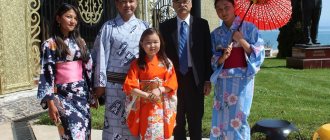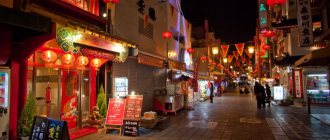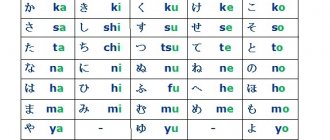Sky-high prices
Selling fruits in Japanese stores is completely different from how they are sold in markets in other countries.
In store windows with a long history, special gift samples of fruit are displayed on soft mats. Triangular or heart-shaped watermelons are not uncommon. On the other hand, foreigners never cease to be surprised at how expensive Japanese fruits are. On a sultry August day, we walked into the coolness of the main store on Nihonbashi, in the very center of Tokyo, where our eyes were drawn to the beautiful fruits lying there like jewels. The cantaloupes, as if carved from jade, emitted a fragrance that lived up to their name "cantaloupe" (14,000 to 21,600 yen each, including tax). The giant Seto grape gave off an emerald glow (12,960 yen per bunch). The fruits were not inferior to real jewelry either in appearance or in price.
American columnist Dave Barry in his book “Dave Barry Does Japan” writes:
The Japanese value melons, and in some of the best department stores in Japan we saw gift melons that cost up to $75 each (about 8,000 yen in 1992).
They were beautiful melons and came in nice little wooden boxes - but $75 a melon? We were told that the Japanese are obsessed with gifts, and the point of such a melon is that the recipient will appreciate the gift because he knows how much it is worth. However, when you give a gift in Japan, etiquette dictates that you should speak disparagingly about it. You can say “that melon is worthless,” or “I must apologize for serving such a melon.” Of course, Americans give a gift worth $75 in a completely different way. If we were giving someone such a melon, then the moment the recipient unwraps it, we would poke him with our index finger: “Do you have any idea how much this melon costs?” We could never forget it, and at parties many years later, when we met someone, we would say: “Hi! My name is Bob. I once gave someone a melon for $75!”
The history goes back 182 years, and now gift items make up 98% of its sales. Therefore, the minimum requirements for goods are good taste and pleasant appearance. The company's clientele is very diverse - these are government and public organizations, trading companies, banks, engineering and construction firms, etc. They even say that some guests from the Middle East, to whom the Japanese gave such melons, send private planes every month to purchase Japanese fruits.
The head of the planning and development department, Oshima Ushio, proudly says that Japanese fruits are the best in the world in terms of quality and taste.
Grapes in the Sambikia store
One of the buyers who was choosing fruit, an English lawyer Nazar Mohammad, who was in Japan on a business trip, said that the prices were indeed very high, but he had never seen such selected grapes that all the berries were so large and was going to buy one bunch so that later eat. However, when he saw white peaches at 3,780 apiece, he was surprised and said that even in London's Harrods, one of the most prestigious department stores, a peach can cost at most 5 pounds (about 650 yen), and in a wholesale store for the price of one peach here you can buy about thirty.
On the left are white peaches at ¥3,780 each, in the middle are egg-shaped peaches, on the right are rojimomo peaches
Hashimoto Yoshihei, 73, who runs his family's three-generation Furutsu Hausu Yoshidaya store in front of Zushi Station, an hour's train ride south of Tokyo, says he buys fruit at the same Central Wholesale Market. Tokyo is the same as Sambikia, but the method of purchasing from Sambikia is different. He buys, for example, a box of fruit in good condition, while Sambikia orders an intermediary company to select the fruit, and picks one out of about thirty boxes.
Watermelon Densuke
These 11 kg watermelons cost $6,100. In general, this variety, grown on the Japanese island of Hokkaido, is similar to the watermelons that are sold in our stores in the summer. So why should you pay $6,100 for one Densuke watermelon? This is probably due to its exceptional juiciness and sweetness. And also because only a hundred of them are sold at a time.
Fruits as “water sweets”
In ancient times, in the traditional Japanese gourmet cuisine of kaiseki-ryori, the fruit was called mizugashi, “water sweets,” and was used as a sweet dessert. In particular, exquisitely fragrant, fleshy and juicy peaches, grapes, pears, and persimmons played an important role. In addition, the culture of giving gifts at the middle and end of the year, o-chugen and o-seibo, has existed since the beginning of the Edo period (1603-1868).
Before the period of rapid economic growth, fruit was considered a luxury and was a holiday treat, but recently Japanese food culture has changed greatly and began to resemble Western culture, where fruit is almost always on the table. And yet, according to the Ministry of Agriculture, Forests and Water Resources, per capita fruit consumption in 2011 was 149 kg in Italy, 116.1 kg in France, and only 50.9 kg in Japan, that is, less half the European amount.
Ruby roman grape
The name and $8,400 price tag aren't the only things that make this grape special. Ruby grapes contain exactly 18 percent sugar, and each berry weighs 20 grams. They may look like ping pong balls, but these juicy grapes are one of the rarest fruits. It is also sold exclusively at auctions.
How carousing destroyed a very beautiful couple: the love story of Vysotsky and Vladi
I love homemade milk and chocolate baths: the skin is moisturized and I relax
Even a capricious thorn will bloom: what needs to be done to make a cactus produce a bud
Fruits as an irreplaceable source of vitamins and water in Europe
Sasaki Shigeyuki, a researcher at the international corporation Takasago, pointed out in 2008 that in Europe there is often very hard water, relatively unsuitable for drinking, and in addition, there are not enough food crops that could be a complete source of vitamins throughout the year, and therefore fruits were necessary for life. High-quality fruits were not particularly important as gifts, and their cultural role was not the same as in Japan. Hisashino Akihiro, who heads the Agricultural Produce Bureau of the Fruit Crops Division of the Ministry of Agriculture, Forests and Water Resources, says monoculture farms specialize in one variety, grow large quantities over large areas, and use the fruits to make wine, jam, and dried fruits, so that the external The beauty of the fruit does not play a special role. Thus, in France, the average area of fields for fruit crops is 29 hectares (2010), and recently there are more and more agricultural enterprises of 100 hectares or more (*1)).
The territory of Japan is elongated and 80% of it is occupied by mountains. In 2010, the average farm area was 2.2 hectares. Of these, 85% were farms engaged in labor-intensive production of fruit crops with an area of 2 hectares or less. Cultivation of fruit crops involves work that cannot be mechanized, requires pruning and other complex technologies, and is therefore very labor-intensive. There are many small farms growing fruit crops in Japan. To increase profitability, they are forced to carefully cultivate varieties that look and taste good. For example, only one fruit is grown on one cantaloupe plant, thanks to this, nutrients are concentrated in it and the melon is fragrant. In Japan, with its abundance of good water, rain and humid climate, fruit crops began to be perceived as a delicacy.
In recent years, Japanese fruits, into which so much work has been invested, have begun to be perceived as luxury goods abroad. Hisashino Akihiro says that if we compare the exports of apples, pears, peaches, tangerines, strawberries, grapes, persimmons and other fruits in 2006 and 2015, they more than doubled and amounted to 18 billion yen.
Persimmon
If you'd rather spend your hard-earned cash on something more substantial, you might want to add the $29 Japanese Persimmon .
On the one hand, 3240 yen is the price for the entire box. However, the box only contains one persimmon, shipped from Komori Farm in Kumamoto Prefecture. At least the box itself is pretty good, made of natural wood.
Opening the box, you will find a piece of fruit accompanied by a small explanatory brochure, as if it were a branded watch or some other exclusive accessory.
Premium Taishu persimmon weighs at least 350 grams, is surprisingly juicy, tender, and has an attractive smell. The initial texture is crisp , almost like an Asian pear and thanks to its extremely fine fibers. According to Omori Farm's boast, premium Taishu is more than 15 times sweeter than regular persimmons.
Again, it must be emphasized that Premium Taishu is not really intended for everyday personal use, and any supermarket in Japan will sell you persimmons for a tenth of the price or less. But if you're looking to splurge on some of Japan's luxury fruits, premium Taishu Persimmon, compared to other high-quality fruits in Japan, is a relatively affordable option. This is an experience that you are unlikely to ever forget, even if you visit Supermarkets in the Land of the Rising Sun.
This is not just a treat, but a symbol of respect
While Europeans tend to eat apples and oranges as daily nutritious snacks, people in Japan consume the fruit much less frequently because they are so overpriced. Even when a family in Japan decides to treat themselves to apples, they will share one apple among everyone. According to CNN, Buddhists, for example, leave fruit as a gift to the gods, a practice that has led to the treats being seen as a symbol of respect. Gifts are an important part of Japanese culture. And it doesn’t matter whether it’s a present for the boss, the owner of the house, or just a sign of gratitude, many people choose fruit for this, which helps show their status.
How are melons grown in Japan?
Before growing this rare variety of melon in a greenhouse, farmers try to select only the best seeds. As soon as the plants begin to sprout, specialists remove all excess buds and pollinate the beautiful shoots by hand using a brush. Once they start to bloom, only the strongest will survive. Greenhouse workers keep one of the best melons on each vine and remove the rest, because the fruit shouldn't compete with others for nutrients.
Melons that receive enough nutrients begin to ripen gradually. Farmers fix the rope around the stems so that the melons do not fall, but calmly “reach” in excellent conditions. Workers trim each vine to the same height. The fruits are covered with a cone-shaped black “hat”, which protects them from the scorching sun. Each fruit receives an individual special massage. Farmers put on white gloves and rub each fruit thoroughly. According to experts, such rubbing helps give the melons an ideal shape and helps create a more beautiful mesh on the skin.
Imagine the color black: an ophthalmologist told how to relieve eye tension
The woman showed a beautiful dressing room, which turned out to be from a small pantry
Who is not alien to rudeness, and who does not think about it: a funny rating of zodiac signs
This is perhaps the most labor-intensive method of all types of melon cultivation throughout Japan. This method even has a name - Shizuoka. Some places do it differently and get several melons from each vine. But this requires even more effort. Those who grow melons practically live on their plots, because there must always be someone there to monitor the harvest.
Purple mangoes
Taiyo no Tomago translates to "egg of the sun". These purple mangoes are created by Japanese farmers and cost $3,000. They are extremely difficult to grow. They are grown only in Miyazaki in Japan. In addition, farmers can only grow them indoors, with a special mesh bag placed over the fruit. This bag allows the fruit to receive maximum sunlight and grow properly. They are characterized by an extremely rich, almost bloody color. They are also larger than other mangoes, but above all, they are incredibly sweet. Due to their unique taste, they are included in the lists of the most desirable fruits in the world.
Put on a hat and other rules from childhood that we constantly broke
Nikolaev's wife insulted the concert producer because of a parking space
The girl gained fame after she hung an advertisement on a pole









